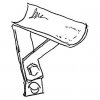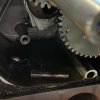Shortly after purchasing The Bride’s LCT 208 Stormforce engine, I also picked up a 60-watt charging coil and electric-start flywheel. I intended to stick with the stock 27-watt coils initially, and upgrade the alternator output down the line, once I’d ridden the bike. Unfortunately, I dropped an M6 steel washer while fabricating an intake support bracket, and it dropped right down behind the flywheel. I couldn’t locate it anywhere, and I was confident it had stuck to one of the magnets. The flywheel needed to come off. I guess it was time to upgrade the charging system after all.
Step one was to whip up a pulling tool. My two-jaw puller was too small to fit, and I’ve never been a fan of “pry-and-pray.” Fortunately, my home-brew pulling rig was just the ticket and the flywheel popped off with a healthy crack.

And there was the little bugger, right where I’d expected to find it.

From that point, installation of the new parts was simple.

Mo’ magnets, mo’ better.

Actually, I don’t understand alternator theory well enough to know if the new flywheel was actually needed, but it’s now a matched set. Sadly, outside of the number of magnets glued to the inside, the two flywheels are virtually identical. No high-RPM shenanigans for this motor! Nobody makes a billet flywheel equipped with charging coil magnets, so this is the best I can do unless I want total-loss lighting and e-start. Which I don’t, obviously.
Step one was to whip up a pulling tool. My two-jaw puller was too small to fit, and I’ve never been a fan of “pry-and-pray.” Fortunately, my home-brew pulling rig was just the ticket and the flywheel popped off with a healthy crack.

And there was the little bugger, right where I’d expected to find it.

From that point, installation of the new parts was simple.

Mo’ magnets, mo’ better.

Actually, I don’t understand alternator theory well enough to know if the new flywheel was actually needed, but it’s now a matched set. Sadly, outside of the number of magnets glued to the inside, the two flywheels are virtually identical. No high-RPM shenanigans for this motor! Nobody makes a billet flywheel equipped with charging coil magnets, so this is the best I can do unless I want total-loss lighting and e-start. Which I don’t, obviously.


















